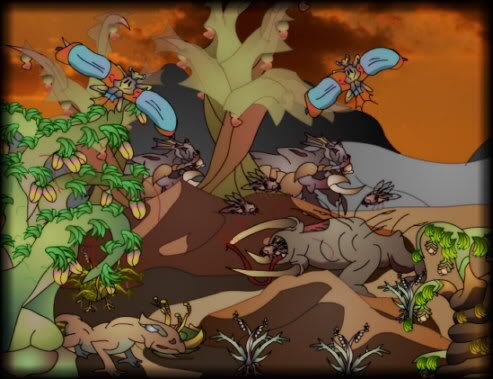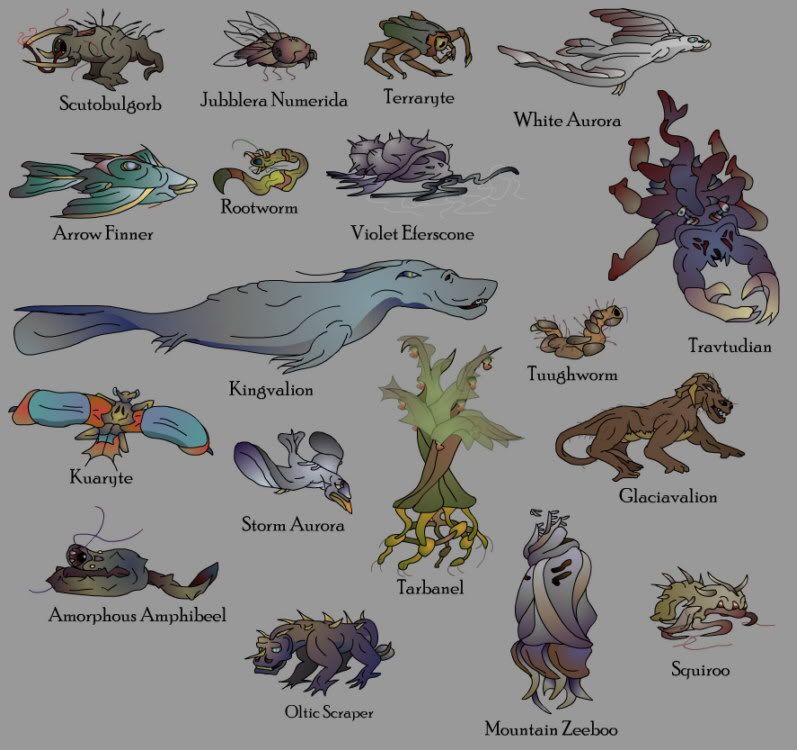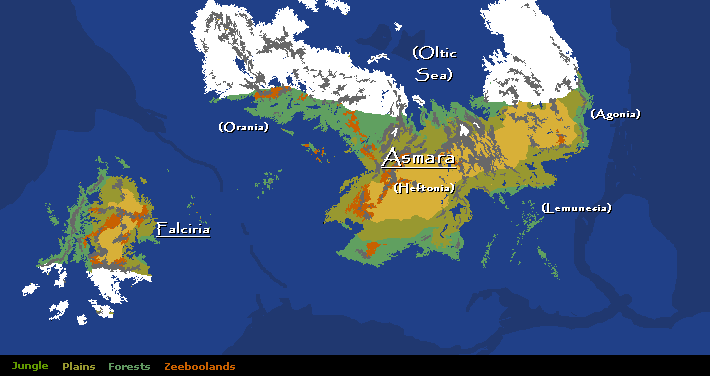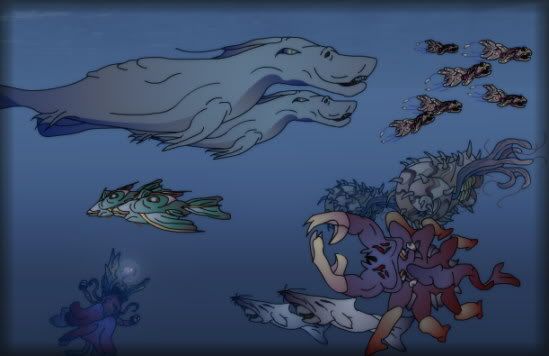Falciria:
This continent remained isolated, with much less bio-diversity. For whatever reason, evolution was slow to happen here. With one exception, the only newcomers were those that could fly, or swim. It was a last refuge for
Saaranixes,
Pre-Finners,
Flevrytes and
Ol Scrapers, all of which carried on their peaceful lives, with only the flying and swimming predators to trouble them.
The
Tuughwurm was the one new native species to appear. It was probably able to dig further and deeper down than any other animal in the world at this time. But it also carried spines and armour plating to protect it on the surface against anything that tried to nibble on it. Tuughwurms were very successful and the ancient Leafworms were soon in danger of extinction.
Notable Plants:
Weak Fern, Tougher Zeeboos, Chungus, Super Lichen, Fire Moss, Buggy Moss, Parasitic Driftseed, Winter Fern
Notable Animals:
Saaranixes, Merlytes, Tuughwurms, Cephrivervalions, Rivervalions, Diggadids, Pre-Leggers, Ol Scrapers, Flevrytes, Blood Auroras, Jubbleras Sensicas, White Auroras
Asmara:
Orania collided with Heftonia to form this new supercontinent. It had plenty of almost every kind of terrain, from mountains and glaciers to plains, forests and deserts. The only thing that was missing was the rainforest of previous eras. But the large Ferns and Fanel trees were long extinct, and the climate was a little too dry for similar plants to evolve.
From Orania came the
Gregarix which was able to spread across Asmara, and was one of the most successful land species at this time. Giving birth to live young helped the herds of Gregarixes stay on the move, and removed the need to sit on nest sites. This was becoming more and more of an advantage in the cold plains, where blooms of
Winter Ferns were very erratic, and the weather could turn very nasty at a moments notice.
The hardy, feathery
Montezuneas were also doing very well. The grazing area of the Montezunea extended further north than most other herbivores could go. Though, unlike the Gregarixes, they would have to retreat to warmer regions in order to lay and incubate their eggs.
Super Leggers, still the largest land animals, were nonetheless in serious decline, probably due to the fact that predators were getting more dangerous, their temperate habitat was increasingly crowded, and they could not survive the colder plains. It was a similar story for the
Double Stomach Legger, though they were greatly helped by their versatile diet.
Pre Leggers were only to be found in Falciria by the end of this era.
After the legendary
Lung Scrapers, the
Oltic Scrapers were probably the most successful of the Scraper/Legger family at this time. Their good rate of speed, defensive spikes, burrowing ability and efficient digestion was a good combination. But like their cousins, they were limited by their dislike of the cold.
Subterradids and
Diggadids had evolved with identical lifestyles on separate continents, but had been going head-to-head since the previous era. The Diggadids were slowly winning, thanks to their improved nervous system and sense of hearing, though there wasn't much in it, and both species lived side by side quite happily. In fact some areas were virtually infested with both of them, as there were no predators able to dig them out and deal with their claws at the same time.
Meanwhile, Orania's
Leafworms,
Flevrytes and
Hiborytes were all wiped out by newcomers from Heftonia...
Uglyworms replaced the Leafworms, with help from the newer
Rootworm species. The
Rootworms were however in competition with the
Diggadids and
Subterradids when it came to eating plant roots.
Glutytes continued to prosper in the cold climate, and from them came the
Terrarytes which were more sophisticated creatures. Though their social skills were not the greatest ever, it seems the Terrarytes already had dedicated 'soldiers' and 'gatherers', if not more different classes. The soldiers were especially unusual in being able to leap on to larger animals and attack with poison-tipped claws. These tactics seem to have been successful enough, though the simpler Glutytes were still more numerous, especially where there was less danger from other animals and food gathering was the main concern.
Flevrytes were replaced on the continent by noisy
Kuarytes which would have been especially common in the temperate forests nearer the equator.
Blood Auroras would probably have been their main predators.
Meanwhile
White Auroras would have been the most widespread of the flying creatures, able to venture far out to sea as well as deep inland. They had the largest wingspan of any flying creature up to this point, and would have been a graceful sight as they sailed on the wind along the shore or across mountain valleys.
 Long-Nosed Auroras
Long-Nosed Auroras would still have been a common sight, especially on tidal flood plains where their beaks could pick out small creatures from the sediments.
The
Jubblera Numerida was a successful new species of acid-spraying fliers. They were highly social, perhaps the most social animals yet seen, and their swarms would have been dangerous to any animal that tried to mess with them. They could probably have reduced a fresh corpse to a skeleton in a matter of minutes. Fortunately for live animals, the Numeridas were not seeking live flesh, though they were able to munch on the most nutritious parts of plants, and would have been a serious problem for plant life in the temperate forests. Despite all this, the humbler and simpler
Jubblera Sensica was still more numerous overall.
Competition between the
Valios Polyteiras and
Travalions continued. This versatile family of hunters continued to well in the temperate regions, as did their relatives the
Rivervalions and
Cephrivervalions. The Polyteiras had a more varied diet and were still most common in the forests. But it was the
Glaciavalion, the descendent of the Travalion, which became the top predator of this era. It had the speed, senses, intelligence and strength to tackle just about any target it set its sights on. And it is also notable for being the first animal to develop 'fur' covering its body, in the same way that the related
Kakoos had first developed feathers many millions of years ago. Unlike the feathers, the fur was probably more waterproof and wear-proof, and slightly easier to re-grow, though it may not have held quite as much heat. In any case, Glaciavalions were still not particularly suited to the cold, and were still unable to roam as far north as animals like the Montezuneas or Terrarytes.

Meanwhile
Flakkerbulgorbs were still quite common, and from them appeared the
Scutobulgorb. This new species was mainly to be found on the forest floor, rooting around for insects and small animals. Their senses remained very poor, and without any real lungs, they could not grow so large, and had a slow metabolism, but all this suited them fine. Though not exactly at the top of the food chain, their jaws were truly fearsome, and even if they could be evaded, a bite to the rear of the animal would still result in a face full of spines, something young Glaciavalions and Polyteiras would quickly learn to avoid.
Finally, the last of the Land Mollusks went extinct, partly due to competition, partly due to the cold.
As for plant life, the
Tarbanel was the first new large plant to appear in a long time, though it was only a slight improvement on the older
Novo Tranel, which still had large populations of its own. Meanwhile the
Ice Zeeboo and the new
Mountain Zeeboo became the most numerous of all the Zeeboos. The Mountain variety in particular was able to spread all throughout the north of Asmara, with gusting mountain winds to carry its airborne seeds for many miles, and was often the only complex lifeform to exist in remote frozen valleys. It could cling to life almost wherever any exposed rock was to be found. Though in such conditions, it could take many centuries before it could produce seeds of its own, especially with long spells in deep hibernation. Their life spans may have stretched over thousands of years. Some suggest they may in fact have been the first Zeeboos to be truly 'immortal', only dying if their surroundings were completely depleted of nutrients.
Notable Animals:
Diggadids, Kunatras, Montezuneas, Terrarytes, Gregarixes, Rootworms, Flakkerbulgorbs, Scutobulgorbs, Cephrivervalions, Double Stomach Leggers, Oltic Scrapers, Jubblerus Sensicas, Jubblerus Numeridas, Black Auroras, Kuarytes, White Auroras, Valios Polyteiras, Glaciavalions
Notable Plants:
Tarbanels, Novo Tranels, Mountain Zeeboos, Tougher Zeeboos, Ice Zeeboo, Chungus, Woody Fanels, Weak Ferns, Winter Ferns, Parasitic Driftseeds, Proto-Moss, Super Lichen, Ground Fuzz



 lanteatingx1, Scalesx1 eyesx1
lanteatingx1, Scalesx1 eyesx1





 ).
).
lanteatingx1, Scalesx1 eyesx1

 .
. I imagine the next biggest creature might come from the Finner family yet again, or maybe a giant shellster extra gigantigus.
I imagine the next biggest creature might come from the Finner family yet again, or maybe a giant shellster extra gigantigus.I imagine the next biggest creature might come from the Finner family yet again, or maybe a giant shellster extra gigantigus.
 . I will sleep on it...
. I will sleep on it...
